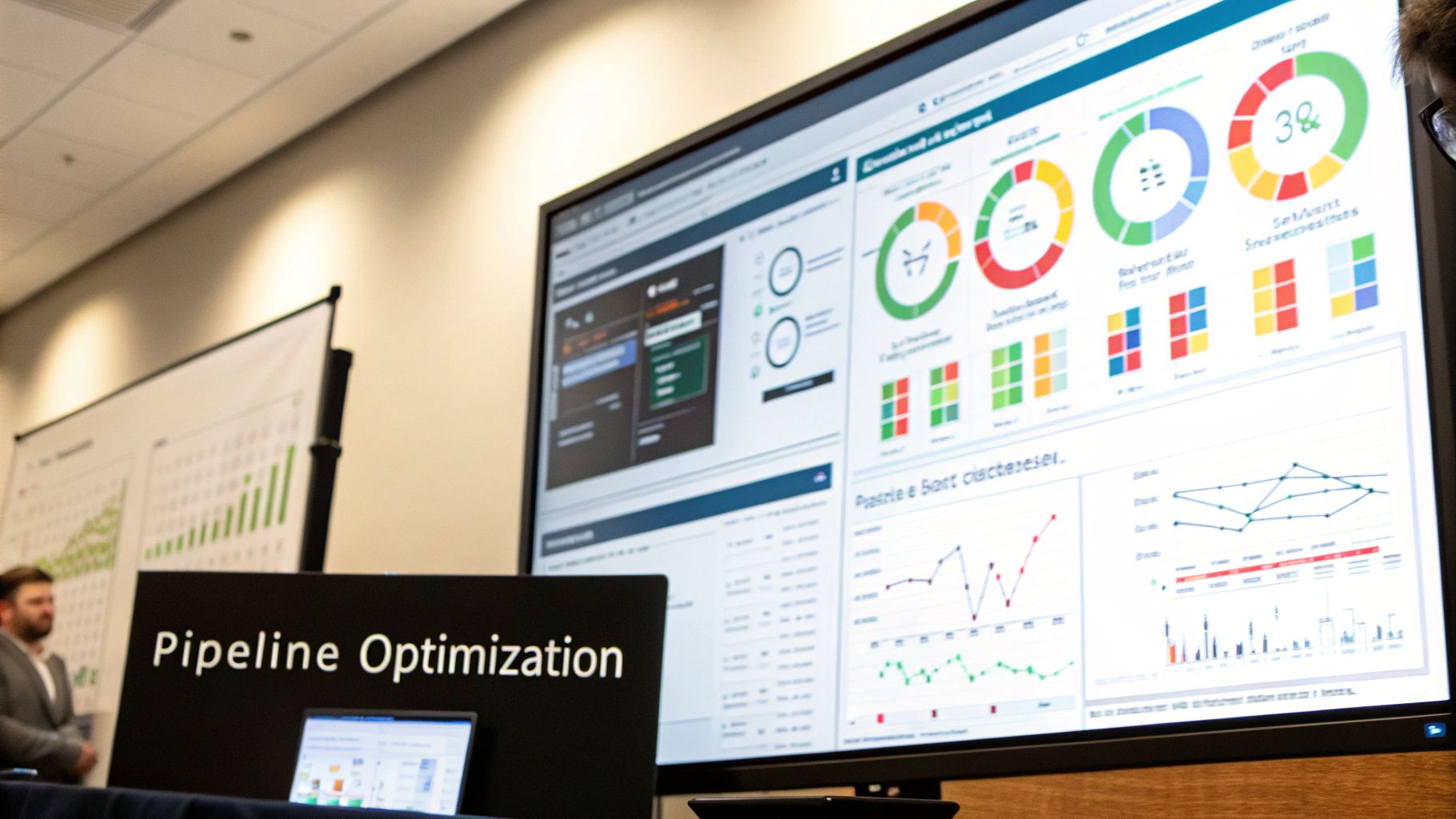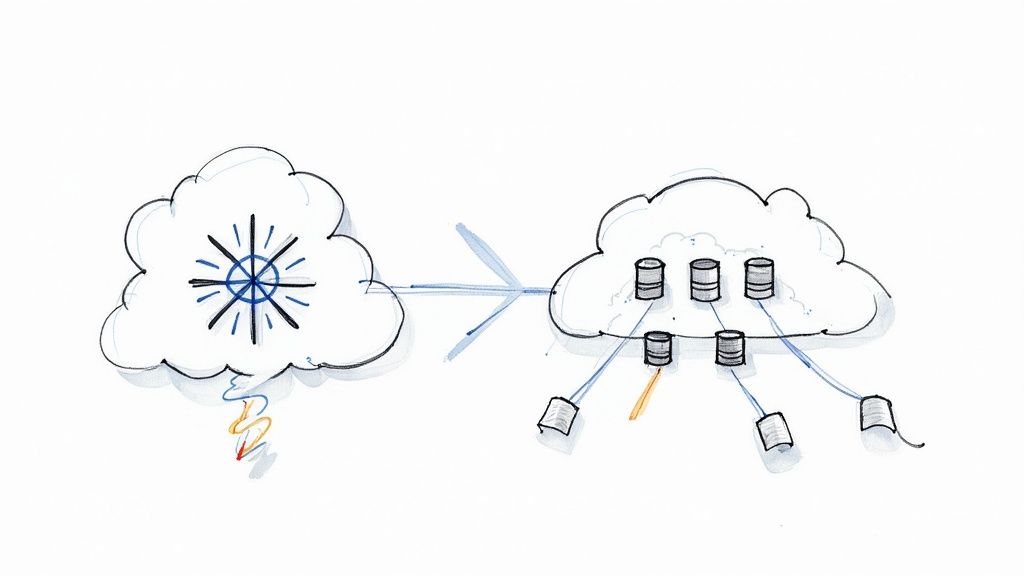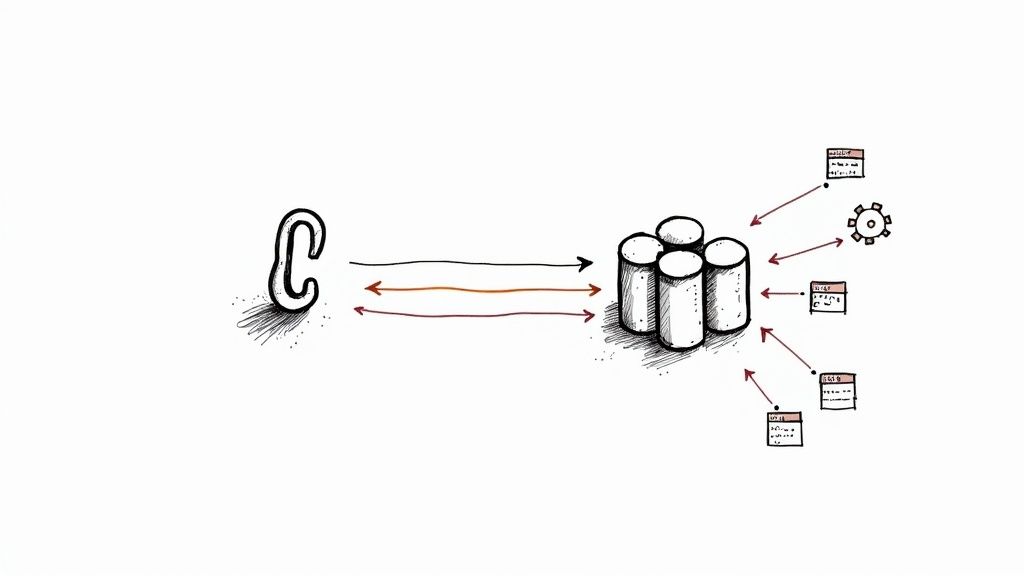How to Build a Data Pipeline That Works: Complete Guide
Learn how to build a data pipeline with this comprehensive guide. Discover architecture, tools, and tips to create efficient data pipelines successfully.
Let's be honest, building a modern data pipeline is about more than just a tech upgrade. It's about ditching the slow, outdated batch processes that have you looking in the rearview mirror and, instead, embracing a real-time approach.
This means creating a direct, streaming connection between your data sources—like your production databases—and your destinations, such as a data warehouse. When you get this right, you unlock the ability to analyze what's happening right now, paving the way for faster, smarter business decisions.
Why Your Business Needs a Modern Data Pipeline Now
Forget the textbook definitions for a moment. A modern data pipeline is the central nervous system of a truly data-driven company. It's what turns data from a static, historical record into a live, dynamic asset you can act on instantly.
Without one, you're always operating with a delay. You're making decisions based on what happened yesterday, last week, or even last month. That kind of latency isn't just an inconvenience; it's a huge business risk.
Relying on outdated systems inevitably leads to flawed decisions and missed opportunities. Think about an e-commerce platform that can’t recommend products based on a user’s current browsing session. Or a logistics company that only flags delivery delays hours after they've already happened. These aren't hypotheticals—they're the real-world consequences of slow, batch-oriented data movement.
From Hindsight to Foresight
The strategic shift happening across industries is crystal clear: businesses are moving away from reactive analysis and toward proactive, in-the-moment operations. A modern pipeline is what makes this change possible.
Here’s what that looks like in practice:
- Real-time Personalization: An online retailer can instantly tailor offers and content as a customer clicks through the site, dramatically improving engagement and boosting sales.
- Predictive Maintenance: A manufacturer can stream sensor data from factory equipment to predict failures before they shut down a production line, saving a fortune in downtime.
- Immediate Fraud Detection: A financial service can analyze transaction streams in milliseconds to block fraudulent activity as it happens, not after the money is gone.
This isn't just a technical adjustment; it’s a fundamental change in how a business operates and competes. It's no surprise that the demand for these capabilities is driving massive market growth. The global data pipeline market was valued at around $10.01 billion in 2024 and is expected to explode to $43.61 billion by 2032. This incredible growth is all about feeding the hunger for robust systems that can support AI, machine learning, and advanced analytics. You can find more details about this trend on Fortunebusinessinsights.
The real value of a modern data pipeline isn't just about moving data faster. It's about closing the gap between an event happening and your ability to do something about it. That's where the competitive advantage is won or lost.
By building a modern data pipeline, you give your organization the power to use live data for immediate operational insights. This foundation is critical for everything from perfecting the customer journey to enabling the complex BI systems that drive business today. To dive deeper, you can learn more about the principles in our guide to real-time data analytics.
Blueprint Your Pipeline Architecture for Success
I've seen it happen too many times: an engineering team gets excited and jumps straight into coding without a solid plan. It's one of the fastest ways to build a data pipeline that crumbles under pressure. Before you write a single line, you need to create a blueprint that maps out how data will move, what happens to it, and where it will finally land.
A good architecture is the difference between a pipeline that just works and one that's scalable, reliable, and actually drives your business forward. Think of it like planning a road trip—you wouldn't just start driving. You'd figure out your starting point, your final destination, and all the crucial stops along the way.
The Five Core Components of Your Pipeline
No matter how complex it gets, every data pipeline boils down to five fundamental parts. Nail these down, and you'll have a clear, actionable blueprint to build from.
- Data Sources: First, where is your data coming from? This could be anything from a classic relational database like PostgreSQL or MySQL, a NoSQL database, APIs from third-party SaaS tools, or real-time event streams from something like Apache Kafka.
- Data Ingestion: Next, how are you going to pull data out of those sources? You might use simple batch processing for data that isn't time-sensitive. But for operational systems where every second counts, you'll want real-time streaming with Change Data Capture (CDC).
- Data Transformation: What do you need to do to the data to make it useful? This is where the magic happens. It could involve cleaning up messy records, structuring raw JSON, joining different datasets, or running aggregations to get it ready for analysis.
- Data Destination: Where is the processed data going to live? The most common destinations today are powerful cloud data warehouses like Snowflake and Google BigQuery, or data lakes if you're storing massive amounts of raw, unstructured data.
- Data Consumers: Finally, who—or what—is going to use this data? The end-user might be a BI tool like Tableau for building dashboards, a machine learning model looking for patterns, or even a customer-facing app that relies on fresh, real-time information.
This infographic really helps visualize how these pieces fit together.

Seeing the entire journey laid out like this makes it easier to spot potential bottlenecks and ensures you don't miss a critical step in your design.
Choosing Your Architectural Pattern ETL vs ELT
Once you've got your core components mapped out, you have a major decision to make: which architectural pattern will you use? The two dominant models are ETL (Extract, Transform, Load) and ELT (Extract, Load, Transform). The only difference is when the transformation happens, but it has huge implications.
In the old-school ETL model, you extract data from the source, transform it on a separate processing engine, and only then load the polished result into the destination. This was the go-to method back when storage and compute were incredibly expensive because it minimized the data you had to keep in the warehouse.
The modern approach, ELT, completely flips the script. You extract the data and load it directly into the data warehouse in its raw, original form. All the heavy-lifting—the transformations—happens right inside the warehouse, taking advantage of its immense processing power.
The rise of cloud data warehouses with their near-infinite scalability and separate billing for storage and compute has made ELT the clear winner for most modern use cases. It just offers so much more flexibility and simplicity.
Let's break down the differences to help you decide which is right for you.
ETL vs ELT Which Architecture Fits Your Needs
Choosing between ETL and ELT really comes down to your specific needs, data volume, and how much flexibility your analysts require. The table below lays out the key distinctions.
FeatureETL (Extract Transform Load)ELT (Extract Load Transform)Transformation StageOccurs in a separate staging area before loading into the warehouse.Occurs directly within the data warehouse after loading.Data AvailabilityOnly transformed, structured data is available for analysis.Raw, untransformed data is available immediately in the warehouse.FlexibilityLess flexible. If new transformations are needed, the entire process must be re-run.Highly flexible. Analysts can run new transformations on raw data at any time.Ideal Use CaseBest for smaller datasets with predefined, rigid transformation rules.Perfect for handling large volumes of structured and unstructured data.
So, what does this look like in the real world? An e-commerce company building a real-time analytics dashboard would absolutely benefit from an ELT architecture. They could load raw clickstream events into Snowflake and then use a tool like dbt to transform that data for different use cases—one model for marketing attribution, another for product recommendations.
On the other hand, a legacy financial system generating fixed compliance reports might still be perfectly happy with a traditional ETL process. Understanding these fundamental data pipeline architectures is the first step to making the right call for your project.
Selecting the Right Tools for Your Data Stack
Once you've got a solid architectural blueprint, it's time to assemble your toolkit. The modern data stack is a crowded space, and picking the right combination of tools can feel a bit like navigating a maze. The goal isn't just to grab the most popular names off the shelf; it's to build a cohesive stack that truly fits your needs—from data volume and speed to your team's skills and, of course, your budget.
This is a decision you want to get right. The tools you choose will have a direct and lasting impact on your pipeline's performance, how well it scales, and what it costs to maintain down the road.
The market for these tools is exploding for a reason. In 2024, the global data pipeline tools market was valued at $12.09 billion, with projections showing it could hit $48.33 billion by 2030. What's really telling is that a massive 78.09% of this revenue comes from the tools themselves, as detailed in this data pipeline tools market report. This shows a clear trend: companies would rather buy great software that automates the work than build everything from scratch.
Core Components of Your Tech Stack
Let's break down the essential categories of tools you'll be looking at. Each one plays a unique and critical role in building a data pipeline that's both powerful and efficient.
- Data Ingestion: This is the front door to your pipeline. Its job is to move data from all your sources—databases, APIs, event streams—into your central destination. Key players here are tools like Fivetran, known for its huge library of connectors for batch or near real-time ingestion, and Streamkap, which specializes in true real-time streaming with Change Data Capture (CDC).
- Data Warehouse/Storage: This is the new home for all your raw and transformed data. Modern cloud data warehouses like Snowflake and Google BigQuery have become the industry standard. Their ability to scale on demand, separate storage from compute, and run incredibly fast queries is a game-changer.
- Data Transformation: After you've loaded data into your warehouse (the "L" in ELT), you need to clean it up, model it, and get it ready for analysis. dbt (Data Build Tool) has really taken over this space. It lets teams apply software engineering best practices like version control and testing to their SQL-based transformation logic.
- Orchestration and Scheduling: Think of this as the conductor for your data orchestra. It makes sure all your jobs run in the right sequence and on schedule. Tools like Apache Airflow or Dagster are designed to help you manage complex dependencies, schedule runs, and keep an eye on the health of your entire pipeline.
Choosing the right tools is a balancing act. A startup with a small team and low data volume will probably lean towards tools that are easy to use and cost-effective. On the other hand, a large enterprise handling terabytes of real-time data will need tools built for extreme performance and rock-solid reliability.
A Practical Decision-Making Framework
Instead of getting bogged down in endless feature comparisons, use these key questions to zero in on what really matters for your organization.
- How fresh does your data need to be? Do your analysts need data updated daily (batch), hourly (near real-time), or within seconds (real-time)? This is probably the single most important question. If you need genuine real-time insights, a CDC streaming tool like Streamkap is a must-have. For less urgent use cases, a batch tool will do the job just fine.
- What's your data volume and complexity? Are we talking about a few gigabytes from a handful of sources, or petabytes streaming in from hundreds? High volume and complexity call for highly scalable cloud warehouses like Snowflake and robust orchestration tools that can handle intricate workflows.
- What are your team's skills? If your team is full of engineers who love Python and are comfortable managing infrastructure, a powerful tool like Airflow offers incredible flexibility. But if your team is more focused on SQL and analytics, a stack combining Fivetran for ingestion and dbt for transformation will likely make them far more productive.
- What's your budget? Open-source tools like Airflow might seem cheaper upfront, but they require a lot of engineering time for setup and ongoing maintenance. Managed SaaS tools usually have a subscription fee but can drastically lower your total cost of ownership by taking care of all the infrastructure, updates, and support for you.
For a more formal evaluation process, this step-by-step guide on selecting the right tech stack offers a comprehensive approach to ensure you’re building for both performance and scalability.
Assembling Your Ideal Stack
Let's see how this framework plays out in a couple of common real-world scenarios.
Scenario 1: The E-commerce Startup
- Needs: They need to analyze customer behavior, track sales in near real-time, and build out marketing dashboards. A data freshness of a few hours is perfectly fine for most of their reporting.
- Team: A small analytics team, very strong with SQL but with limited engineering resources to spare.
- Ingestion: Fivetran makes it simple to pull data from sources like Shopify, Google Analytics, and their production database without writing code.
- Warehouse: Google BigQuery is a great fit with its serverless, pay-as-you-go model that helps keep costs predictable and low.
- Transformation: dbt Core lets them model the raw data into clean, analysis-ready tables using the SQL they already know.
- Orchestration: A simple scheduler, like the one built into dbt Cloud, is all they need to run transformations right after Fivetran finishes a sync.
Scenario 2: The FinTech Scale-up
- Needs: Their world revolves around real-time fraud detection, live dashboards for customers, and instant operational analytics. Latency needs to be measured in seconds, not hours.
- Team: A seasoned team of data engineers who are comfortable with streaming technologies and managing complex systems.
- Ingestion: Streamkap is the clear choice here to stream database changes from PostgreSQL and MySQL via CDC, delivering data in real time.
- Warehouse: Snowflake provides the high-performance query engine they need to handle massive concurrent workloads from both analytics and user-facing applications.
- Transformation: dbt running on top of Snowflake allows them to continuously model the incoming streaming data as it arrives.
- Orchestration: Dagster is ideal for managing their complex, hybrid batch-and-stream pipelines with its data-aware orchestration capabilities.
By starting with your actual business needs and constraints, you can confidently choose a set of tools that truly empowers your team and delivers measurable value.
Building a Real-Time Data Pipeline From Scratch

Alright, enough with the theory. Let's get our hands dirty and actually build something. A real-time data pipeline isn't just an architectural diagram; it's a living system you can stand up to solve a real business problem.
We're going to tackle a classic, high-impact use case: streaming customer updates from a PostgreSQL database straight into a Snowflake data warehouse. This is a scenario I see constantly. Companies need their operational data reflected in their analytics environment now, not tomorrow.
For this job, we’ll use Streamkap. It’s built for real-time Change Data Capture (CDC), meaning it can grab every single INSERT, UPDATE, and DELETE from the database transaction log. The best part? It does this without hammering your source system with heavy queries.
Laying the Groundwork: Your Source and Destination
Before any data can start moving, we need to prep both ends of the pipe. This means tweaking your PostgreSQL database to allow for logical replication and getting your Snowflake account ready with the right permissions for data ingestion.
First up, PostgreSQL. To get CDC working, you need to set the wal_level to logical. This is usually a quick edit in your postgresql.conf file.
-- In your postgresql.conf file
wal_level = logical
You'll also want to create a dedicated user with replication privileges. This is just good security hygiene. It ensures your pipeline tool has just enough permission to read the change log and nothing more.
CREATE ROLE streamkap_user WITH REPLICATION LOGIN PASSWORD 'your_secure_password';
GRANT SELECT ON ALL TABLES IN SCHEMA public TO streamkap_user;
With the source squared away, let's turn to Snowflake. Here, you'll need to set up a database, schema, and warehouse to receive the data stream. You'll also need a user role with the necessary privileges to create tables and write the incoming data.
Configuring the CDC Connector
This is where the magic happens. Using a platform like Streamkap makes this part surprisingly straightforward because it handles the messy complexities of managing Kafka or Debezium for you. Instead, you get a clean UI to point your source at your destination.
Here's what that process generally looks like:
- Pinpoint Your Source: You'll select PostgreSQL and plug in the connection details we just prepared—host, port, database, and the credentials for our dedicated
streamkap_user. - Target Your Destination: Next, choose Snowflake and provide the connection info, including your account URL, warehouse, database, and the user role you set up.
- Define the Data Stream: This is key. You don't have to drink from the firehose and stream your entire database. You can be selective, choosing specific schemas or tables like
customersandordersto keep your pipeline lean and focused.
One of the biggest wins of a managed CDC platform is how it handles schema evolution automatically. If someone adds a new column to your PostgreSQL customers table, the system just detects it and alters the target table in Snowflake to match. This feature alone prevents so many pipeline failures and saves countless hours of manual fixes.
Once that’s done, the pipeline is effectively live. Streamkap will connect to your PostgreSQL database, start tailing the write-ahead log (WAL), and stream any changes through its engine and into Snowflake tables that perfectly mirror your source schema.
Handling Transformations In-Flight
A raw feed of database changes is a great start, but it’s rarely in the exact shape you need for analysis. You might need to mask sensitive PII, flatten a nested JSON object, or add a new field based on existing data. This is where in-flight transformations shine.
Most modern streaming platforms let you apply these simple transformations as the data is on the move. For example, you could set up a rule to pseudonymize a customer's email address before it ever touches down in Snowflake.
This is incredibly powerful for a few reasons:
- Compliance: You can ensure PII is handled correctly from the moment it leaves the source system.
- Efficiency: It saves you from having to run a separate transformation batch job inside Snowflake, which simplifies your overall data architecture.
- Enrichment: You can easily add useful metadata to every record, like a timestamp showing when the event was processed.
Of course, for more complex, multi-step business logic, you'll still probably use a tool like dbt on top of your Snowflake data. But for these common, record-level tweaks, doing it in the stream is the most efficient path. To see how this works under the hood, check out our deep dive on real-time data streaming, which gets into the core technologies.
Essential Production-Ready Practices
Getting a pipeline running is one thing. Making it reliable enough for production is a whole different ballgame. As soon as data is flowing, your job shifts to monitoring, logging, and smart error handling. A pipeline that fails silently is a ticking time bomb.
Here's your checklist for a truly production-ready pipeline:
- Comprehensive Logging: Make sure your tool gives you detailed logs. You need the ability to trace a single record's journey from source to destination if you ever need to debug an issue.
- Proactive Monitoring: Set up dashboards to keep an eye on vital signs like pipeline latency (the lag between a source change and its appearance in the destination), data volume, and error rates.
- Alerting on Anomalies: Don't wait for users to report bad data. Configure alerts that ping your team the moment latency spikes, data volume drops off a cliff, or errors start climbing.
- Dead-Letter Queues (DLQ): A DLQ is a non-negotiable safety net. If a record fails to process—maybe due to a data type mismatch—it gets shunted to a separate queue for you to inspect later instead of bringing the entire pipeline to a screeching halt. This keeps clean data flowing without interruption.
By following these practical steps, from initial setup to robust monitoring, you can build a real-time data pipeline that stops being a blueprint and starts delivering real, immediate value.
How to Optimize and Scale Your Data Pipeline

Getting your data pipeline built is a huge win, but honestly, that's just the starting line. The real challenge begins now: making sure it can handle more data, more users, and more complexity without falling over or costing a fortune. An unoptimized pipeline is a ticking time bomb. A well-scaled one, on the other hand, becomes a serious competitive advantage.
This is where the work shifts from just getting data from A to B, to moving it smartly. It’s a constant loop of tuning performance, managing resources, and keeping a close eye on everything.
Fine-Tuning for Performance and Cost
When your data volume starts to climb, even tiny inefficiencies can snowball into massive performance bottlenecks and eye-watering cloud bills. The trick is to stop thinking of resource consumption as a fixed cost and start treating it as a variable you can control.
One of the most powerful levers you can pull is data partitioning. I’ve seen this make a world of difference in data warehouses like Snowflake. Simply partitioning a massive table by date or customer ID can slash query times from agonizing minutes down to seconds. That means your transformation jobs finish faster and burn through fewer compute credits.
Another area I always look at is resource allocation for streaming components. It's so tempting to over-provision resources "just in case," but that's a surefire way to waste money. Instead, you should lean heavily on autoscaling. Let the system spin up more resources when traffic is heavy and then scale back down when things are quiet. You only pay for what you use.
There's a reason the cloud-based data pipeline market is set to explode from $12.26 billion in 2025 to $43.61 billion by 2032. Companies are embracing the cloud to get this exact kind of elasticity without the infrastructure headaches. Just look at Netflix—they manage petabytes of data every single day with cloud-native pipelines to power their real-time analytics. If you want to dig deeper, you can learn more about mastering cloud pipeline management.
Implementing Robust Data Governance
As your pipeline becomes the lifeblood for more and more teams, you absolutely have to protect the integrity of the data. A single, undocumented change from a source system can cause a catastrophic ripple effect downstream, breaking critical dashboards and killing trust in your data. This is where data governance stops being a buzzword and becomes a daily necessity.
Data governance isn't about restricting access; it's about creating trust. When everyone knows where the data came from, what it means, and that it's reliable, its value skyrockets.
A great place to start is with schema validation right at the entry point of your pipeline. Think of it as a bouncer at the door—it checks every piece of incoming data and rejects anything that doesn't match the expected format. This simple step prevents bad data from ever poisoning your system.
For a more robust solution, look into data contracts. This is a formal agreement between the people creating the data (like an app development team) and the people using it (like your analytics team). It clearly defines the schema, what the fields mean, and the quality standards. If a producer wants to change something, like renaming a field, the contract forces a validation check and alerts the downstream consumers. No more nasty surprises.
Proactive Monitoring and Alerting Strategies
You never want to be the last to know your pipeline is broken. Even worse is hearing about it from an angry stakeholder. A solid monitoring and alerting strategy helps you spot trouble and fix it before most people even realize there was a problem. The goal is to get out of "break-fix" mode and into a more predictive, proactive state.
Here are a few of the core metrics I always track:
- Data Freshness: How old is the data by the time it lands in the warehouse? This is your end-to-end latency.
- Data Volume: Are you seeing the expected number of records per hour? A sudden nosedive can signal a silent failure somewhere upstream.
- Error Rates: How many records are failing transformations or ending up in a dead-letter queue? A sudden spike is a clear red flag.
Don’t just track them—set up automated alerts. For instance, have an alert fire off a notification to your on-call engineer if data freshness creeps past your 15-minute service-level agreement. This kind of proactive oversight is what transforms a fragile pipeline into a resilient system that’s truly ready to scale.
Answering Your Top Data Pipeline Questions
When you first start building data pipelines, a few questions always seem to pop up. It's completely normal to hit a few roadblocks. Let's walk through some of the most common ones I hear from engineers and data teams to get you moving forward.
What's the Real Difference Between a Data Pipeline and ETL?
It’s easy to see why these two get tangled up, but the distinction is actually pretty straightforward once you see it.
Think of a data pipeline as the entire transportation system—the roads, the signs, the bridges—that moves data from one place to another. It's the whole shebang.
ETL (Extract, Transform, Load) is just one specific route you can take on that system. It's a common and well-established pattern, but it's not the only one out there. You also have patterns like ELT and, of course, real-time streaming. So, every ETL process is a data pipeline, but not all data pipelines are ETL.
How Can I Actually Guarantee Data Quality?
This is a big one. Data quality isn't a "set it and forget it" task; it has to be a core part of your pipeline's DNA from day one.
- Validate Upfront: Your first line of defense is at the source. Validate schemas right at ingestion to catch and reject bad data before it ever has a chance to contaminate your system.
- Automate Your Quality Checks: Build cleansing and normalization steps directly into your transformation logic. I'm a big fan of using tools like dbt tests to automatically flag things like unexpected nulls, duplicate entries, or values that fall outside a valid range.
- Use Data Contracts: This is a game-changer. Formalize an agreement between the teams that produce the data and the teams that consume it. This simple step prevents a lot of headaches, like when an upstream team renames a field and unknowingly breaks everything downstream.
A pipeline filled with bad data is actually worse than having no pipeline at all. It actively leads to wrong decisions. You simply have to invest in automated quality checks and solid governance—it's the only way to build trust in your data.
Should We Build Our Own Pipeline or Buy a Solution?
Ah, the classic build vs. buy dilemma. A few years ago, this was a tougher debate, but today, for the vast majority of companies, buying a managed solution is the clear winner.
Building a pipeline from scratch is a massive resource sink. You're not just building it once; you're signing up to debug, maintain, and scale it forever. That's a full-time job for a team of engineers.
Modern SaaS tools give you pre-built connectors, managed infrastructure, and scalability on demand. This approach lets you get a working pipeline in days, not months. It frees up your engineering talent to focus on what creates business value—deriving insights from the data—instead of managing plumbing.
What's a Realistic Budget for a Data Pipeline?
The cost can swing dramatically, from a few hundred dollars a month to well over $10,000. The final number really boils down to three things: the volume of data you're moving, how complex your transformations are, and your choice of tools.
Your main costs will typically break down into:
- Cloud Infrastructure: What you pay your cloud provider (AWS, GCP, etc.) for compute and storage.
- Software Licensing: The subscription fees for your various tools for ingestion, transformation, or visualization.
- Engineering Time: Don't forget this one. It's often the biggest expense—the cost of your team's time spent building and maintaining the pipeline.
A smart way to keep costs in check is to lean on cloud-native, serverless tools. They automatically scale with your workload, so you're truly only paying for the resources you use at any given moment.
Ready to build a real-time data pipeline without the usual complexity and high cost? Streamkap is a managed CDC platform that lets you stream data from sources like PostgreSQL and MySQL to destinations like Snowflake in just a few minutes. Start your free trial today and see how easy it can be.



